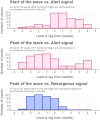Assessing the utility of the COVID-19 epidemic Situations of Concern classification system in guiding operational responses to the pandemic in the WHO African region: retrospective analysis
- PMID: 40777633
- PMCID: PMC12328326
- DOI: 10.3389/fpubh.2025.1562525
Assessing the utility of the COVID-19 epidemic Situations of Concern classification system in guiding operational responses to the pandemic in the WHO African region: retrospective analysis
Abstract
During a public health emergency, early implementation of response activities is crucial for saving lives and protecting livelihoods. The COVID-19 pandemic, declared by the World Health Organization (WHO) on March 11, 2020, posed a global public health crisis that required timely decision-making despite limited data and capacity. In this context, WHO's Regional Office for Africa (AFRO) developed the Situations of Concern (SOC) classification system to assess and monitor epidemiological risk across its 47 Member States. We conducted a retrospective analysis to evaluate the performance and operational utility of the SOC system. Using weekly country-level COVID-19 surveillance data, we found that the system demonstrated strong alignment with epidemic wave patterns, with a sensitivity of 83% and specificity of 88%. SOC classifications supported timely operational decision-making in over 70% of documented support instances. Effective management of limited resources through SOC assessments also helped ensure fair distribution of support across communities. Our findings suggest that adaptable classification systems like SOC can provide effective decision-support under conditions of limited data availability, improving outbreak preparedness and response in resource-constrained settings.
Keywords: COVID-19; SAR-CoV-2; Situation of Concern; WHO African region; epidemic.
Copyright © 2025 Ogundiran, Abbate, Kim, Diallo, Muteba, Camara, Bianchi, Balde, Oyugi, Fortin, Baykika-Tusiime, Williams, Mboussou, Okot, Mutoka Banza, Laundry, Ejiofor, Kanyowa, Kamara, Atuhebwe, Gumede, Herring, Woldetsadik, Okeibunor, Koua, Chamla, Braka and Gueye.
Conflict of interest statement
The authors declare that the research was conducted in the absence of any commercial or financial relationships that could be construed as a potential conflict of interest. The reviewer PR declared a shared affiliation with the author(s) DC to the handling editor at the time of review.
Figures





References
-
- World Health Organization . (2020). Statement on the second meeting of the international health regulations (2005) emergency committee regarding the outbreak of novel coronavirus (2019-nCoV). Available online at:https://www.who.int/news-room/detail/30-01-2020-statement-on-the-second-...
Publication types
MeSH terms
Grants and funding
LinkOut - more resources
Full Text Sources
Medical
Miscellaneous

